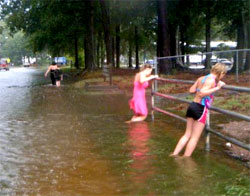
How much is the region spending to address Sanitary Sewer Overflows (SSOs) and who is paying the bill? 
Basically, anytime untreated sewage gets out of the sewer system there is a problem. Every effort is made to design, construct, and operate the system so that no sewage ever gets out of the system. However, occasionally some does due to a variety of reasons including blockages, damage to pipes, mechanical failures, vandalism, or very heavy rain or unusually high tides.
Prior to the current emphasis on SSOs, each locality and HRSD were doing a number of things to minimize SSOs with the total regional investment in the tens of millions of dollars each year. The increased emphasis and aggressive schedule will accelerate the pace of this on-going work and will likely require hundreds of millions of dollars over the foreseeable future. The funds for this work will come from the individual rate payers throughout the region, both with the collection system maintenance fee charged by the individual localities and the sewage conveyance and treatment fee charged by HRSD. These rates are predicted to increase over the next several years to accommodate the increased spending need. More definitive cost information will be developed with the Regional Wet Weather Management Plan.
Why does this matter to you?
This is your tax money Hampton Roads is spending. We need to show our support for alternate methods of low cost sewer rehabilitation in order to save our tax money from being wasted. They are currently in a pilot program testing the viability of trenchless technology. We need to let the Virginia Department of Environmental Quality, the Virginia State Water Control Board and all the members of the 13 involved Hampton Roads localities know we support cured in place pipe lining and that it has been tested and proven safe and effective.
The Hampton Roads Sanitation District HRSD has been working with 13 of the Hampton Roads localities and the Virginia Department of Environmental Quality (DEQ) to develop a plan to study the regional sewer system and identify improvements that can be made to reduce the frequency and severity of sanitary sewer overflows (SSOs). Each locality and HRSD will take specific actions over the next few years to develop a Regional Wet Weather Management Plan (RWWMP) to minimize SSOs.
Trenchless methods are being considered at this point in a pilot program. We need to let them know we care how our money is spent and want to have a say in how much money we are spending.
See Full Article Here
http://www.hrsd.com/EPAWWCD.shtml
